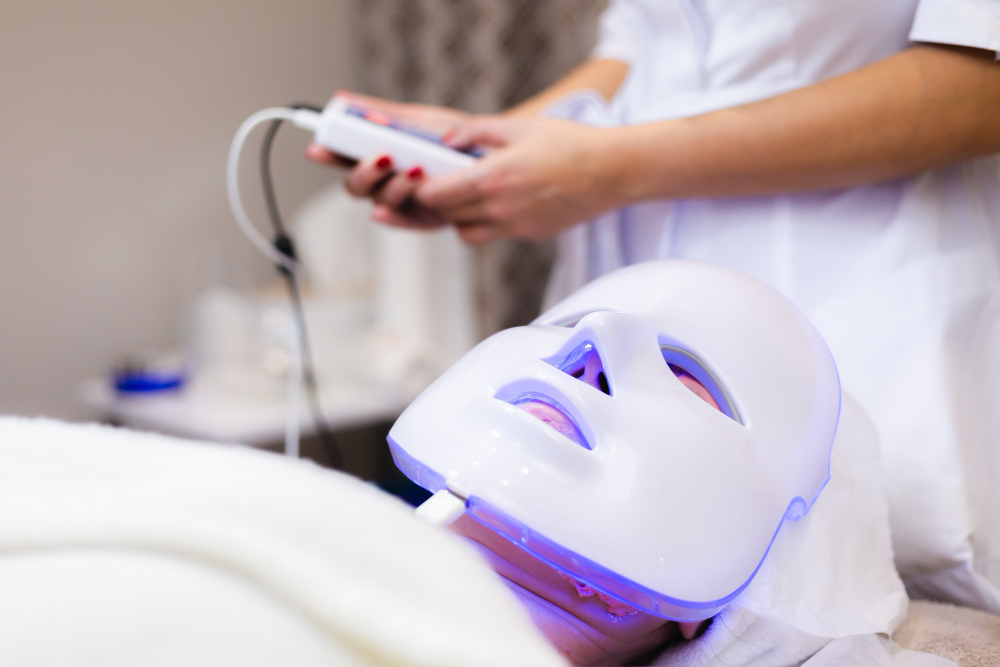If you’ve ever scrolled through skincare TikTok or seen glowing selfies with futuristic-looking face masks, chances are you’ve come across LED light therapy. It looks high-tech (and to be fair, it is), but dermatologists have used this skincare innovation for decades. Now, thanks to wearable at-home devices, more people than ever are discovering how they can help with everything from breakouts to fine lines.
So what’s really going on when your face is bathed in red, blue, or near-infrared light? Let’s break it down.
What Is LED Light Therapy, Exactly?
LED stands for Light Emitting Diode. These diodes release specific wavelengths of light that can penetrate the skin at different depths, triggering various biological processes. Unlike UV light, which can damage skin cells, LED light is non-invasive and non-damaging. Depending on the wavelength (or color), LED light can promote healing, kill acne-causing bacteria, or stimulate collagen production.
Red and near-infrared light are particularly popular for anti-aging benefits, while blue light is often used to treat acne. Some devices even combine multiple wavelengths to deliver comprehensive skin support in a single session.
The Science Behind the Glow
Let’s talk biology for a second. When your skin absorbs specific wavelengths of light, it jump-starts processes at the cellular level. Red light, for instance, stimulates mitochondria, the “powerhouse” of your cells, to produce more ATP (adenosine triphosphate), which is the energy currency that supports cell repair and regeneration.
This increased energy production can lead to:
- Enhanced collagen and elastin synthesis
- Improved blood circulation
- Reduced inflammation
- Accelerated healing of blemishes or scarring
It’s not magic; it’s biostimulation. And over time, those micro-improvements at the cellular level can translate to visibly smoother, firmer, and clearer skin.
What Can LED Light Therapy Help With?
LED light therapy has a range of potential benefits, depending on the light used and your specific skin concerns. Here are some of the most common ways people use it:
- Fine lines and wrinkles: Red and near-infrared light can help plump the skin by boosting collagen production.
- Acne and breakouts: Blue light is known to destroy acne-causing bacteria on the skin, reducing flare-ups without drying out your skin like harsh topicals.
- Skin tone and texture: By encouraging cellular turnover and reducing inflammation, LED therapy can smooth rough patches and even out hyperpigmentation.
- Post-procedure healing: Many dermatologists use LED treatments post-chemical peel or microneedling to calm the skin and reduce downtime.
What to Expect from At-Home Devices
Home-use LED masks and panels have come a long way in recent years. While professional in-clinic devices may deliver faster results, many at-home models use clinically validated wavelengths and are effective with consistent use.
The key here is consistency. Most manufacturers recommend using your LED device three to five times per week, with visible results typically appearing after four to six weeks. Sessions are usually short, around 10 to 20 minutes, making it easy to add to your nighttime routine.
Also, safety matters. Look for a product that has been independently tested and approved for home use. Comfortable fit, eye protection, and built-in safety timers are all important features to look for.
The Bottom Line: Is LED Light Therapy Worth It?
If you’re looking for a non-invasive, science-backed way to support your skin health, LED light therapy is well worth considering. It’s gentle, suitable for nearly all skin types, and addresses a wide range of concerns, from acne and inflammation to wrinkles and uneven tone.
Ready to see the glow for yourself? Maysama’s clinically backed red light therapy mask makes it easy to experience the benefits of LED technology at home. Whether you’re new to light therapy or looking to upgrade your routine, it’s a skin investment that just might pay off.

